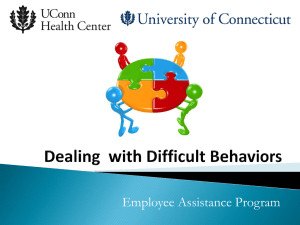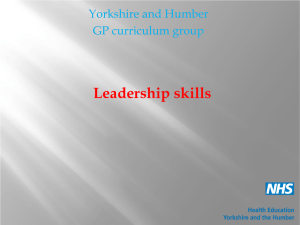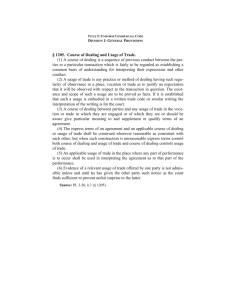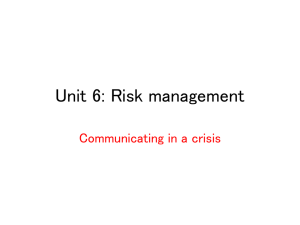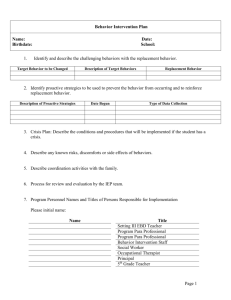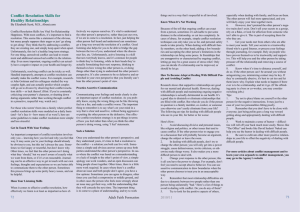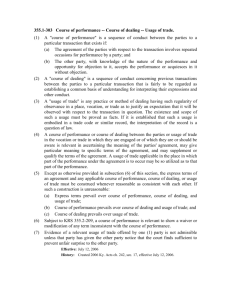Stop & Think Parents
advertisement
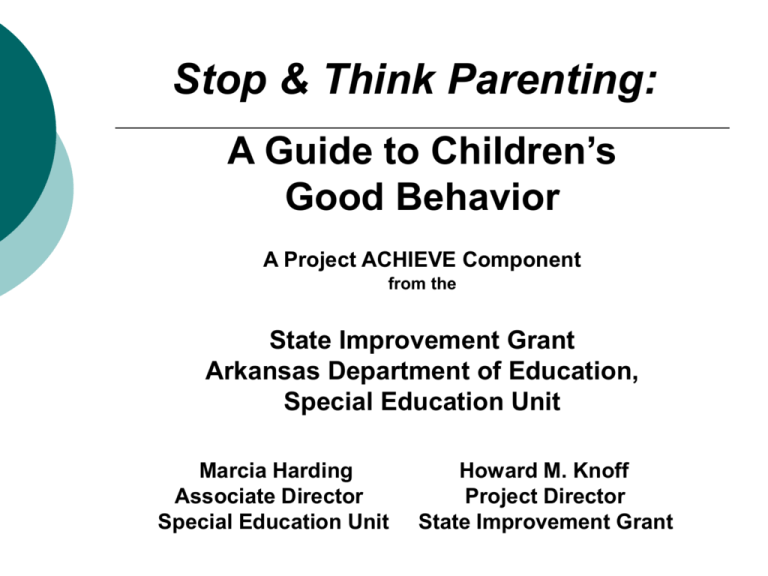
Stop & Think Parenting: A Guide to Children’s Good Behavior A Project ACHIEVE Component from the State Improvement Grant Arkansas Department of Education, Special Education Unit Marcia Harding Associate Director Special Education Unit Howard M. Knoff Project Director State Improvement Grant The Stop & Think Social Skills Program (within Project ACHIEVE) An Evidence-Based National Model Prevention Program through the U.S. Department of Health & Human Service’s Substance Abuse and Mental Health Services Administration (SAMHSA) and U.S. Department of Justice’s Office of Juvenile Justice and Delinquency Prevention (OJJDP) Character is doing the right thing. . . . . when no one is watching. J. C. Watts Choice, not chance, determines one’s destiny. Unknown The Goal of the Stop & Think Social Skills Program TO: Teach Children Interpersonal, ProblemSolving, and Conflict Resolution Skills That facilitate their Social-Emotional/ Behavioral Development, and Help them develop Self-Management Skills The “BIG THREE” Interdependent Positive Behavioral Support Components Skill (Interpersonal, Problem-Solving, Conflict Resolution Social Skills) Accountability Consistency The Definition of “Skill Mastery” Skills are mastered when they are successfully performed under conditions of emotionality “Special Situations”— Dealing with Emotions Skills: The Emotional Reaction Paradigm: Prevention Triggers Cues Behavior Prepare Skills can be demonstrated as long as a person is not past the “Physiological Point of No Return” STEP 1: STOP AND THINK Time to calm down and think about how to handle the situation. STEP 2: Do You Want to Make a Good Choice OR A Bad Choice? Opportunity to decide what kind of choice to make? STEP 3: What Are Your Choices or Steps? Teaching Step and then Thinking or Planning Step STEP 4: Just Do It! Do the behavior or action STEP 5: Tell Yourself “Good Job!” Child reinforces self for making a good choice then doing a good job. THE STOP & THINK SOCIAL SKILLS UNIVERSAL LANGUAGE 1. ________, you need to Stop & Think. 2. Are you going to make a Good Choice or a Bad Choice? You need to make a Good Choice. 3. What are your (Good) Choices or Steps? [Tell/Guide your student here using a specific “Skill Script”] 4. All right, now let me see you Just Do It ! ! ! 5. Great job! ! ! Tell yourself you did a great job ! ! ! Preschool to Early Elementary School Stop & Think Social Skills At the preschool to the early elementary school level, the ten primary skills are: Listening Following Directions Using a Friendly Voice Waiting for Your Turn How to Interrupt Asking for Help Asking for Permission (May I?) Dealing with Being Bothered Apologizing Dealing with Losing At the preschool to early elementary school level, the ten advanced skills are: Sharing Joining an Activity Dealing with Being Left Out Dealing with Teasing Dealing with Consequences Planning What to do Next Deciding How You Feel Dealing with Anger Dealing with Being Blamed Deciding with Being Afraid Middle to Late Elementary School Stop & Think Social Skills At the middle to late elementary school level, the ten primary skills are: Listening Following Directions Asking for Help Taking Turns/Interrupting Ignoring Distractions Apologizing Dealing with Consequences Dealing with Teasing Dealing with Anger Walking Away from a Fight At the middle to late elementary school level, the ten advanced skills are: Setting a Goal Understanding Your/Others’ Feelings Evaluating Yourself Dealing with Being Rejected or Left Out Responding to Failure Dealing with Accusations Beginning/Ending a Conversation Dealing with Fear Giving/Accepting a Compliment Dealing with Peer Pressure Teaching Social Skills: The Importance of Skills & Script “Stop & Think” “I’m going to make a Good Choice!” “What are my Choices or Steps?” THE SKILL BOX: GO TO SKILL SCRIPT “Now, I’m ready to ‘Just do it!’” “Great! I did a Great Job!” “Skills and Scripts”-In Step 3’s “Skill Box” Listening: (For Younger Students) 1. 2. 3. 4. 5. Eyes are forward. Hands are quiet. Mouth is closed. Ears are open. “Show me Listening!” Prompt: “Show me listening.” Following Directions: [“Show Me Listening”– Get into the Listening position] 1. Listen to the entire direction. 2. Repeat the direction to yourself or out loud. 3. Ask a question if needed or if you don't understand. 4. Get ready to follow the direction. REMEMBER: “Bad Choices” are not failures; They are opportunities to teach, reteach, reinforce, and demonstrate consistency with children and adolescents. The “BIG THREE” Interdependent Positive Behavioral Support Components Skill Accountability (Incentives, Consequences) Consistency Necessary Components of an Effective Discipline/Behavior Management Program Accountability: Children make “good choices” because they are either motivated toward incentives and/or motivated to avoid consequences. Implication: We need to identify meaningful, developmentally-appropriate incentives and consequences for children/adolescents Some Basic Principles of Accountability 1. A positive home environment occurs when children experience FIVE positive interactions for every ONE negative interaction. TO 2. Incentives and consequences impact only after a child has learned and mastered specific social skills (Think about the non-swimmer). Implication: When incentives and consequences are used too early in connection with skill mastery, frustration (emotionality) results. Some Basic Principles of Accountability 3. When consequences are needed, the mildest possible consequence needed to motivate a student’s “good choice” should be used. 4. Even when used correctly, as consequences get more negative or intense, some children need at least the same level of intensity in order for them to maintain their “meaningfulness” over time. Implication: This can result in a “death spiral” where parents are continually increasing the intensity of their consequences in order to get their children to respond. Some Basic Principles of Accountability 5. Punishment may immediately stop behavior but it does not change behavior; Consequences: Communicate. . . and Motivate. BUT. . . . “If you consequate, you must educate!” Implication: Once the consequence is over, the child needs to understand and practice the appropriate action to change the behavior. Positive Home Behavior Matrix Positive Home Behaviors Listens Follows Directions (Cleans room, makes bed, puts clothes/toys away, gets ready for bed easily, good personal hygiene, ____________________) Uses a friendly voice (not angry, loud, whiny, __________) Waits their turn (when you are on the phone, visiting with a friend, busy cooking, ____________________) Walks away from a fight (when hit by younger sibling, when being bullied or teased, ______________) Tells the truth Shares, Shows kindness ________________________ Incentives – (What does your child like?) 1. Tell child “Thank you” 2. Special privileges (Play with computer or Playstation, extra TV time, outside play) 3. Have a snack 4. Smile and affirmation (“Good Work” “Good job” “I appreciate you/what you did” ) 5. Say, “I love you” 6. Spend extra time together (Story time, Cooking, Wal-Mart) 7. Hug, high five, or a loving pat 8. ______________________ Level 1 Mild Inappropriate Behaviors Does not listen (TV watching, you are reading a story, giving directions, or helping with homework, _____________) Does not follow directions (Delays going to bed or bathing, leaves toys or clothes on floor, slams door, _______) Uses a loud voice, makes loud noises, or has an attitude (when asking for help, interacting with others, frustrated, _______________) Interrupts your phone call or interrupts you when you are busy Teases a sibling or friend Corrective Responses (Organized along a Continuum) Parent proximity Parent non-verbal redirect (“The Look”, point, Stop & Think hand signal, ) Parent verbal redirect “Stop & Think” process Child practices desired action/ appropriate behavior Parent ends activity Child apologizes 2 minute “time out” Mild reduction of privileges: (Computer, Playstation, TV, Outside Playtime, ____________) ____________________________ The “BIG THREE” Interdependent Positive Behavioral Support Components Skill Accountability Consistency (Structured, Predictable, Dependable) Examples of the Types of Consistency/Inconsistency Need Consistency: Across Parents Across Expectations Across Time, Settings, and Situations Across Siblings (taking into account the age) The Necessary Components of an Effective Discipline/Behavior Management Program Skill Skill Accountability Accountability Consistency Consistency The Stop & Think Parenting DVD Introduction Listening and Following Directions—The Basics Listening and Following Directions—Advanced Procedures Using Rewards and Consequences Teaching Children to Wait their Turn and How to Interrupt Children’s Emotions and Dealing with Losing Teaching Children How to Accept Consequences Teaching Children and Parents How to Deal with their Anger Summary Applying Social Skills toward Prompting Behavioral Change Targeting Behaviors for Change: Increasing or establishing new behaviors Decreasing or eliminating inappropriate behaviors Teaching attention & engagement skills Teaching social, self-management & self-control skills Addressing externalizing behavior (anger, acting out, aggression) Addressing internalizing behavior (anxiety, withdrawal, depression) Increasing student motivation Peer engagement & management skills Identifying Replacement Behaviors Replacement behaviors describe desired skills or outcomes Replacement behaviors cannot be described using “not,” “stop,” or “don’t” Replacement behaviors must be: Observable Measurable Attainable/realistic Identifying Replacement Behaviors Problem Behavior Interrupting Taking Sibling’s Toy Verbal Taunts Throwing Food Slamming Door Swearing Begging in store Replacement Behavior ? THE STOP & THINK SOCIAL SKILLS PRACTICE ACTIVITY 1. 2. ________, you need to Stop & Think. I’m sorry that you are making a Bad Choice right now (by __________________________ ). You need to make a Good Choice. 3. Your Good Choice is to (state Replacement Behavior) . [Tell/Guide your student here using a specific “Skill Script”] 4. All right, now let me see you Just Do It ! ! ! 5. Great job! ! ! Thank you for making this Good Choice and following my directions! ! ! Questions to Ask Yourself Have I effectively taught my child the social skills I expect him/her to perform? Has my child reasonably mastered those skills? Am I using meaningful incentives and consequences to motivate good choices and good behavior? Am I being consistent in how I use and apply incentives and consequences? Am I getting the good-choice behavior that I want from my child?
